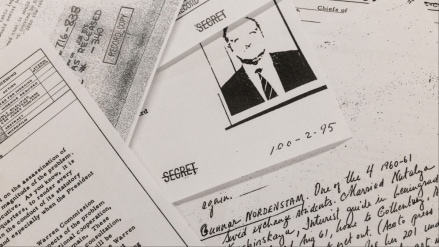The latest release of top-secret files on the 1963 assassination of John F. Kennedy has reignited intrigue, offering fresh insight into long-debated conspiracy theories. The 2,182 newly unsealed documents—totaling 63,400 pages—were published by the National Archives on Tuesday evening, prompting historians, experts, and political observers to sift through them for new revelations.
While many files lack annotations, agency origins, or credibility assessments, some details stand out. The release has shed light on key figures such as Gary Underhill, a CIA agent who claimed a “small clique” within the intelligence agency was responsible for Kennedy’s death, and Jack Ruby, the nightclub owner who killed assassin Lee Harvey Oswald just days after Kennedy’s murder.
Jack Ruby’s Deeper Ties to Organized Crime
One of the most compelling discoveries is new evidence linking Jack Ruby more extensively to organized crime. Born Jacob Leon Rubenstein in Chicago, Ruby had a history of involvement in illegal gambling and racketeering. Previously dismissed as a lone actor seeking vengeance for Kennedy, the new files suggest Ruby may have been directed to silence Oswald before he could reveal deeper conspiracies.
Stephen Fagin, curator at the Sixth Floor Museum, noted that Ruby remains central to many theories. “For some, he’s the Rosetta Stone of the JFK conspiracy. For others, he’s just a man who acted on impulse to avenge Kennedy.”
CIA Agent’s Chilling Claim on Deep State’s Role
A resurfaced passage from the 1967 left-wing magazine Ramparts has also drawn renewed attention. It recounts the story of Gary Underhill, a former U.S. Army captain and intelligence agent, who fled Washington the day after the assassination. According to the document, Underhill was in a state of panic, claiming the CIA was behind the assassination and that he feared for his life. Six months later, he was found dead in his Washington apartment—officially ruled a suicide.
Lee Harvey Oswald: A ‘Poor Shot’ and KGB Target
Another surprising detail found in the declassified files contradicts the official narrative of Oswald’s skill as a marksman. Reports indicate that while Oswald was under surveillance by the KGB during his time in the Soviet Union, he was considered a “poor shot” during target practice. This revelation casts further doubt on the claim that Oswald single-handedly fired the fatal shots from the Texas School Book Depository.
Did the Secret Service Ignore an Early Warning?
A newly uncovered letter from 1978 details a chilling warning about Oswald months before Kennedy’s assassination. A man named Sergyj Czornonoh wrote to the British Embassy, claiming that he had informed American Vice Consul Tom Blackshear in July 1963 that Oswald planned to kill the president. Despite this early warning, Oswald was never apprehended or closely monitored upon his return to the U.S.
Trump’s Push for Transparency—And Redactions That Remain
The document dump follows a long-standing promise by Donald Trump to release all remaining JFK files, a pledge dating back to his first term. However, while thousands of pages have now been declassified, experts have noted that many files still contain redactions, fueling frustration among researchers and conspiracy theorists alike.
Jefferson Morley, vice president of the Mary Ferrell Foundation, called the release “an encouraging start,” but emphasized that two-thirds of the promised files remain undisclosed. Historian Larry Sabato echoed similar concerns, noting that deciphering the documents could take months or even years due to the lack of organization and missing context.
Despite the revelations, historians caution that the new files are unlikely to fundamentally alter the long-standing understanding of Kennedy’s assassination. But with lingering questions about Oswald’s true motivations, Ruby’s connections, and potential intelligence failures, the debate surrounding JFK’s murder is far from over.
